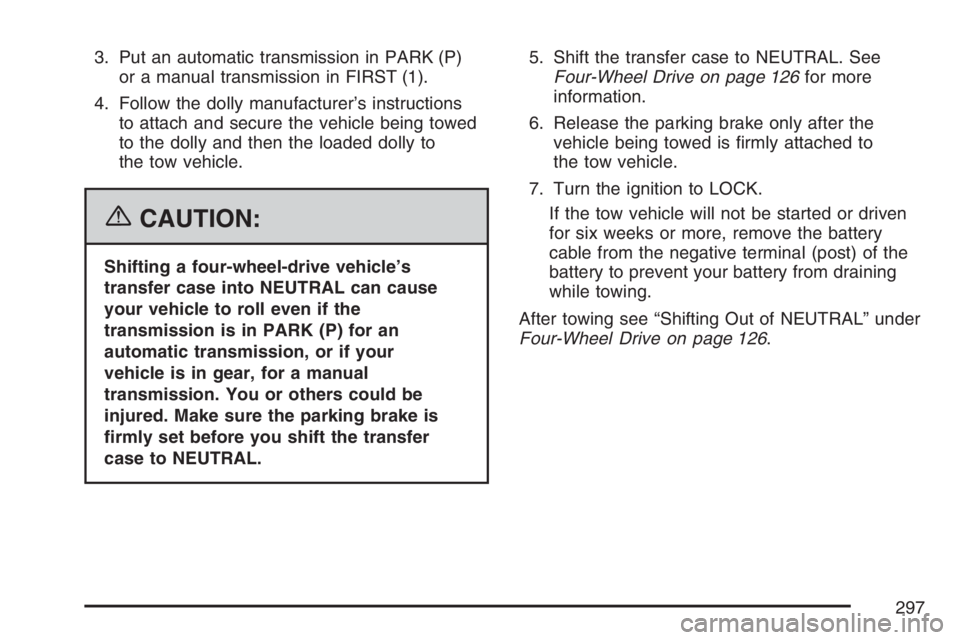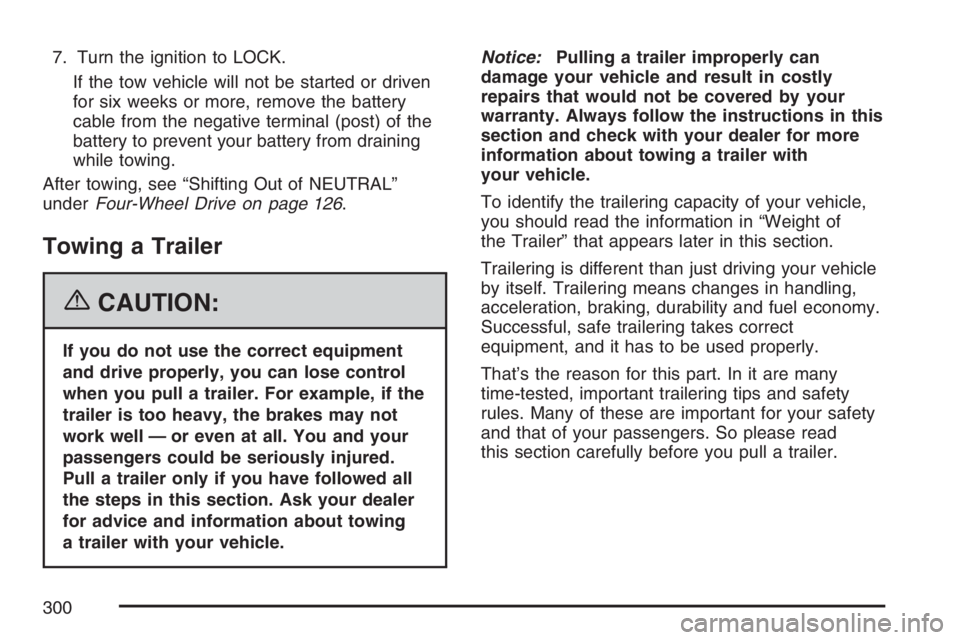2007 GMC CANYON four wheel drive
[x] Cancel search: four wheel drivePage 296 of 492

Dolly Towing
Front Towing
(Front Wheels Off the Ground)
Two-Wheel-Drive Vehicles
Notice:If you tow a two-wheel-drive vehicle
with the rear wheels on the ground, the
transmission could be damaged. The repairs
would not be covered by your warranty.
Never tow your vehicle with the rear wheels
on the ground.
Two-wheel-drive vehicles should not be towed with
the rear wheels on the ground. Two-wheel-drive
transmissions have no provisions for internal
lubrication while being towed. To dolly tow a
two-wheel-drive vehicle, you must tow the vehicle
with the rear wheels on the dolly. See “Rear Towing
(Rear Wheels Off the Ground)” later in this section
for more information.
Four-Wheel-Drive Vehicles
Use the following procedure to dolly tow your
vehicle from the front:
1. Drive the vehicle onto the dolly.
2. Firmly set the parking brake. SeeParking
Brake on page 130for more information.
296
Page 297 of 492

3. Put an automatic transmission in PARK (P)
or a manual transmission in FIRST (1).
4. Follow the dolly manufacturer’s instructions
to attach and secure the vehicle being towed
to the dolly and then the loaded dolly to
the tow vehicle.
{CAUTION:
Shifting a four-wheel-drive vehicle’s
transfer case into NEUTRAL can cause
your vehicle to roll even if the
transmission is in PARK (P) for an
automatic transmission, or if your
vehicle is in gear, for a manual
transmission. You or others could be
injured. Make sure the parking brake is
�rmly set before you shift the transfer
case to NEUTRAL.5. Shift the transfer case to NEUTRAL. See
Four-Wheel Drive on page 126for more
information.
6. Release the parking brake only after the
vehicle being towed is �rmly attached to
the tow vehicle.
7. Turn the ignition to LOCK.
If the tow vehicle will not be started or driven
for six weeks or more, remove the battery
cable from the negative terminal (post) of the
battery to prevent your battery from draining
while towing.
After towing see “Shifting Out of NEUTRAL” under
Four-Wheel Drive on page 126.
297
Page 299 of 492

Four-Wheel-Drive Vehicles
Use the following procedure to tow your vehicle
from the rear:
1. Drive the vehicle onto the dolly.
2. Firmly set the parking brake. SeeParking
Brake on page 130for more information.
3. Put an automatic transmission in PARK (P)
or a manual transmission in FIRST (1).
4. Follow the dolly manufacturer’s instructions
to attach and secure the vehicle being towed
to the dolly and then the loaded dolly to
the tow vehicle.For manual transmission vehicles, make sure
the wheels are straight before proceeding
to the next steps. On automatic transmission
vehicles, use an adequate clamping device
to ensure that the front wheels are locked into
the straight position.
{CAUTION:
Shifting a four-wheel-drive vehicle’s
transfer case into NEUTRAL can cause
your vehicle to roll even if the
transmission is in PARK (P) for an
automatic transmission, or if your vehicle
is in gear, for a manual transmission.
You or others could be injured. Make sure
the parking brake is �rmly set before you
shift the transfer case to NEUTRAL.
5. Shift the transfer case to NEUTRAL. See
Four-Wheel Drive on page 126for more
information.
6. Release the parking brake only after the
vehicle being towed is �rmly attached to the
tow vehicle.
299
Page 300 of 492

7. Turn the ignition to LOCK.
If the tow vehicle will not be started or driven
for six weeks or more, remove the battery
cable from the negative terminal (post) of the
battery to prevent your battery from draining
while towing.
After towing, see “Shifting Out of NEUTRAL”
underFour-Wheel Drive on page 126.
Towing a Trailer
{CAUTION:
If you do not use the correct equipment
and drive properly, you can lose control
when you pull a trailer. For example, if the
trailer is too heavy, the brakes may not
work well — or even at all. You and your
passengers could be seriously injured.
Pull a trailer only if you have followed all
the steps in this section. Ask your dealer
for advice and information about towing
a trailer with your vehicle.Notice:Pulling a trailer improperly can
damage your vehicle and result in costly
repairs that would not be covered by your
warranty. Always follow the instructions in this
section and check with your dealer for more
information about towing a trailer with
your vehicle.
To identify the trailering capacity of your vehicle,
you should read the information in “Weight of
the Trailer” that appears later in this section.
Trailering is different than just driving your vehicle
by itself. Trailering means changes in handling,
acceleration, braking, durability and fuel economy.
Successful, safe trailering takes correct
equipment, and it has to be used properly.
That’s the reason for this part. In it are many
time-tested, important trailering tips and safety
rules. Many of these are important for your safety
and that of your passengers. So please read
this section carefully before you pull a trailer.
300
Page 310 of 492

Parking on Hills
{CAUTION:
You really should not park your
vehicle, with a trailer attached, on a hill.
If something goes wrong, your rig could
start to move. People can be injured,
and both your vehicle and the trailer can
be damaged.
But if you ever have to park your rig on a hill,
here’s how to do it:
1. Apply your regular brakes, but don’t shift into
PARK (P) yet, or into gear for a manual
transmission. When parking uphill, turn your
wheels away from the curb. When parking
downhill, turn your wheels into the curb.
2. Have someone place chocks under the trailer
wheels.
3. When the wheel chocks are in place, release
the regular brakes until the chocks absorb
the load.4. Reapply the regular brakes. Then apply your
parking brake, and then shift into PARK (P),
or REVERSE (R) for a manual transmission.
SeeParking Brake on page 130for more
information.
5. If you have a four-wheel-drive vehicle, be sure
the transfer case is in a drive gear and not in
NEUTRAL. SeeFour-Wheel Drive on page 126
for more information.
6. Release the regular brakes.
When You Are Ready to Leave After
Parking on a Hill
1. Apply your regular brakes and hold the pedal
down while you:
start your engine,
shift into a gear, and
release the parking brake.
2. Let up on the brake pedal.
3. Drive slowly until the trailer is clear of the
chocks.
4. Stop and have someone pick up and store
the chocks.
310
Page 313 of 492

Service........................................................ 316
Accessories and Modi�cations................... 316
California Proposition 65 Warning.............. 317
Doing Your Own Service Work.................. 317
Adding Equipment to the Outside of
Your Vehicle.......................................... 318
Fuel............................................................. 318
Gasoline Octane........................................ 318
Gasoline Speci�cations.............................. 318
California Fuel........................................... 318
Additives................................................... 319
Fuels in Foreign Countries........................ 320
Filling the Tank......................................... 320
Filling a Portable Fuel Container............... 322
Checking Things Under the Hood.............. 323
Hood Release........................................... 323
Engine Compartment Overview.................. 324
Engine Oil................................................. 325Engine Oil Life System.............................. 328
Engine Air Cleaner/Filter............................ 330
Automatic Transmission Fluid.................... 331
Manual Transmission Fluid........................ 334
Hydraulic Clutch........................................ 336
Engine Coolant.......................................... 337
Radiator Pressure Cap.............................. 340
Engine Overheating................................... 340
Cooling System......................................... 342
Engine Fan Noise..................................... 347
Power Steering Fluid ................................. 348
Windshield Washer Fluid........................... 349
Brakes...................................................... 350
Battery...................................................... 353
Jump Starting............................................ 354
Rear Axle.................................................... 359
Four-Wheel Drive........................................ 359
Front Axle................................................... 360
Section 5 Service and Appearance Care
313
Page 355 of 492

Put an automatic transmission in PARK (P) or
a manual transmission in NEUTRAL before
setting the parking brake. If you have a
four-wheel-drive vehicle, be sure the transfer
case is not in NEUTRAL.
Notice:If you leave your radio or other
accessories on during the jump starting
procedure, they could be damaged.
The repairs would not be covered by
your warranty. Always turn off your radio
and other accessories when jump
starting your vehicle.
3. Turn off the ignition on both vehicles. Unplug
unnecessary accessories plugged into the
cigarette lighter or the accessory power
outlets. Turn off the radio and all lamps that
are not needed. This will avoid sparks
and help save both batteries. And it could
save the radio!
4. Open the hoods and locate the positive (+)
and negative (−) terminal locations on the
other vehicle. Your vehicle has a remote
positive (+) and a remote negative (−) jump
starting terminal. SeeEngine Compartment
Overview on page 324for more information on
the terminal locations.
{CAUTION:
Using a match near a battery can cause
battery gas to explode. People have been
hurt doing this, and some have been
blinded. Use a �ashlight if you need more
light.
Be sure the batteries have enough water.
You do not need to add water to the
ACDelco
®battery (or batteries) installed in
your new vehicle. But if a battery has �ller
caps, be sure the right amount of �uid is
there. If it is low, add water to take care of
that �rst. If you do not, explosive gas
could be present.
Battery �uid contains acid that can burn
you. Do not get it on you. If you
accidentally get it in your eyes or on your
skin, �ush the place with water and get
medical help immediately.
355
Page 359 of 492

Rear Axle
When to Check and Change Lubricant
It is not necessary to regularly check rear axle
�uid unless you suspect there is a leak or you hear
an unusual noise. A �uid loss could indicate a
problem. Have it inspected and repaired.
How to Check Lubricant
To get an accurate reading, the vehicle should be
on a level surface.The proper level is from 0 to 3/8 inch
(0 mm to 10 mm) below the bottom of the
�ller plug hole, located on the rear axle.
What to Use
SeeRecommended Fluids and Lubricants on
page 447to determine which kind of lubricant
to use.
Four-Wheel Drive
Lubricant checks in this section apply to this
vehicle. There are two additional systems that
need lubrication.
Transfer Case
When to Check Lubricant
Refer to the Maintenance Schedule to determine
how often to check the lubricant. SeeAdditional
Required Services on page 440.
How to Check Lubricant
To get an accurate reading, the vehicle should be
on a level surface.
359